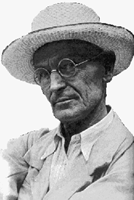Hermann Hesse (1877-1962)
 |
Das Gedicht: |
German poet and novelist, who has depicted in his works the duality of spirit and nature, body versus mind and the individual's spiritual search outside the restrictions of the society. Hesse was awarded the Nobel Prize for Literature in 1946.
Hermann Hesse was born into a family of Pietist missionaries and religious publishers in the Black Forest town of Calw, in the German state of Wüttenberg on July 2, 1877. His parents expected him to follow the family tradition in theology. Hesse entered the Protestant seminary at Maulbronn in 1891, but he was expelled from the school. After unhappy experiences at a secular school, Hesse worked in several jobs.
In 1899 Hesse published his first works, Romantische Lieder and Eine Stunde Hinter Mitternacht . Hesse became a freelance writer in 1904, when his novel Peter Camenzind gained literary success. The book reflected Hesse's disgust with the educational system. In the same year he married Maria Bernoulli, with whom he had three children. A visit to India in 1911 interested Hesse in studies of Eastern religions and culminated in the novel Siddhartha (1922). It was based on the early life of Gautama Buddha. The culture of the ancient Hindus and the ancient Chinese had a great influence on Hesse's works.
In 1912 Hesse and his family took a permanent residence in Switzerland. In the novel Rosshalde (1914) Hesse explored the question of whether the artist should marry. The author's reply was negative. During these years his wife suffered from growing mental instability and his son was seriously ill. Hesse spent the years of World War I in Switzerland, attacking the prevailing moods of militarism and nationalism. Hesse's breakthrough novel was Demian (1919). It was a Faustian tale of a man torn between his orderly bourgeois existence and a chaotic world of sensuality.
Leaving his family in 1919, Hesse moved to Montagnola, in southern Switzerland. In 1922 appeared Siddhartha , a novel of asceticism set in the time of Buddha. Its English translation in the 1950s became a spiritual guide to the generation of American Beat poets. Hesse's second marriage to Ruth Wenger (1924-27) was unhappy. These difficult years produced Der Steppenwolf (1927). During the Weimar Republic (1919-1933) Hesse stayed aloof from politics.
In 1931 Hesse married his third wife, Ninon Dolbin, and began in the same year work on his masterpiece Das Glasperlenspiel , which was published in 1943. In 1942 Hesse sent the manuscript to Berlin for publication. It was not accepted by the Nazis and the work appeared for the first time in Zürich. . Hesse's other central works include In Sight of Chaos (1923), a collection of essays, the novel Narcissus and Goldmund (1930) and Poems (1970).
After receiving the Nobel Prize Hesse wrote no major works. He died of cerebral hemorrhage in his sleep on August 9, 1962 at the age of eighty-five. He is still one of the best-selling German writers throughout the world.